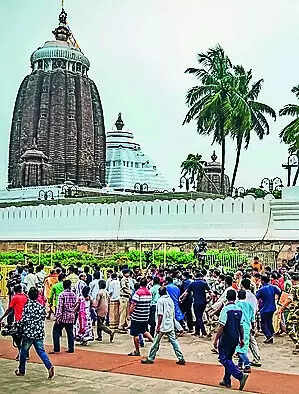Temple: Puri Jagannath Temple Gates Opened by Odisha BJP Government | Bhubaneswar News

Bhubaneswar: The Puri Jagannath Temple witnessed a surge of emotion and enthusiasm from devotees as the newly formed BJP govt threw open all four gates of the shrine in the presence of chief minister Mohan Majhi and his council of ministers on Thursday. Public access from all four gates of the shrine was a major pre-poll promise of the BJP.
Prior to this, only the Lion’s gate, which was the main entrance on the east side of the temple, was kept open for entry and exit of devotees while the Tiger, Horse and Elephant gates situated on the west, south and northern sides of the shrine, had remained closed since March 2020.
“As per the wish of Lord Jagannath, all doors of the temple have been reopened in the presence of the govt. The district and police administrations have been asked to streamline the darshan system and take adequate crowd-control measures. Convenience of devotees and smooth conduct of rituals are the priority areas,” chief minister Majhi said.
The closure of the three gates caused inconvenience to devotees, compelling worshippers to endure lengthy waiting period outside the main entrance.
The decision to throw open all the entrances has alleviated the plight of devotees. Sources said the district administration, police and Shree Jagannath Temple Administration (SJTA) held a joint meeting after the chief minister’s visit and would soon come up with detailed guidelines for a smooth darshan system.
The opening of the temple gates was met with great enthusiasm by devotees. “We used to wait for several hours amid heavy rush at the one gate. The opening of the other three gates has come as a huge relief for us,” said Priyanka Pattnaik, a devotee from Bhubaneswar.
While the move is expected to enhance the overall experience of devotees visiting the shrine, reducing the time spent in queues, the motive behind the closure of the gates for the last four years remains a mystery.
Earlier, the govt had claimed that the three doors were closed to pave the way for unhindered work of the Shree Mandira Parikrama project, which was inaugurated in January this year. However, the doors were not opened even after the completion of the project, causing massive resentment among the public.
Prior to this, only the Lion’s gate, which was the main entrance on the east side of the temple, was kept open for entry and exit of devotees while the Tiger, Horse and Elephant gates situated on the west, south and northern sides of the shrine, had remained closed since March 2020.
“As per the wish of Lord Jagannath, all doors of the temple have been reopened in the presence of the govt. The district and police administrations have been asked to streamline the darshan system and take adequate crowd-control measures. Convenience of devotees and smooth conduct of rituals are the priority areas,” chief minister Majhi said.
The closure of the three gates caused inconvenience to devotees, compelling worshippers to endure lengthy waiting period outside the main entrance.
The decision to throw open all the entrances has alleviated the plight of devotees. Sources said the district administration, police and Shree Jagannath Temple Administration (SJTA) held a joint meeting after the chief minister’s visit and would soon come up with detailed guidelines for a smooth darshan system.
The opening of the temple gates was met with great enthusiasm by devotees. “We used to wait for several hours amid heavy rush at the one gate. The opening of the other three gates has come as a huge relief for us,” said Priyanka Pattnaik, a devotee from Bhubaneswar.
While the move is expected to enhance the overall experience of devotees visiting the shrine, reducing the time spent in queues, the motive behind the closure of the gates for the last four years remains a mystery.
Earlier, the govt had claimed that the three doors were closed to pave the way for unhindered work of the Shree Mandira Parikrama project, which was inaugurated in January this year. However, the doors were not opened even after the completion of the project, causing massive resentment among the public.
We also published the following articles recently














